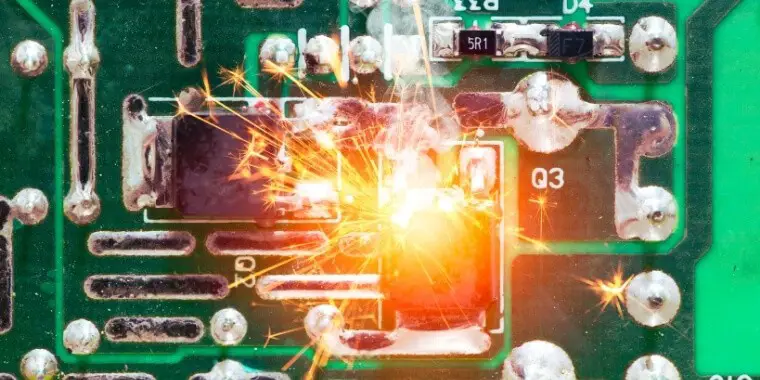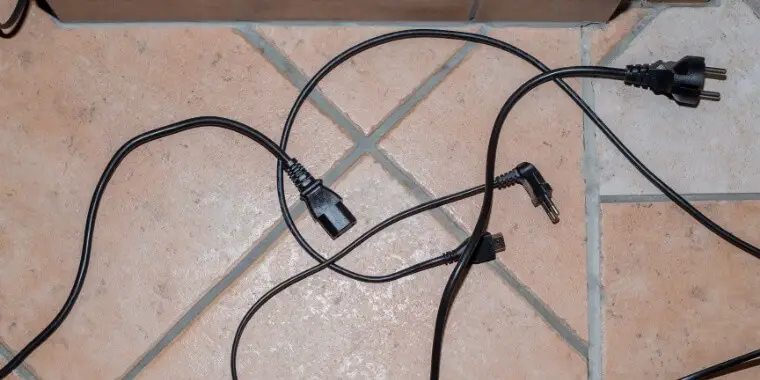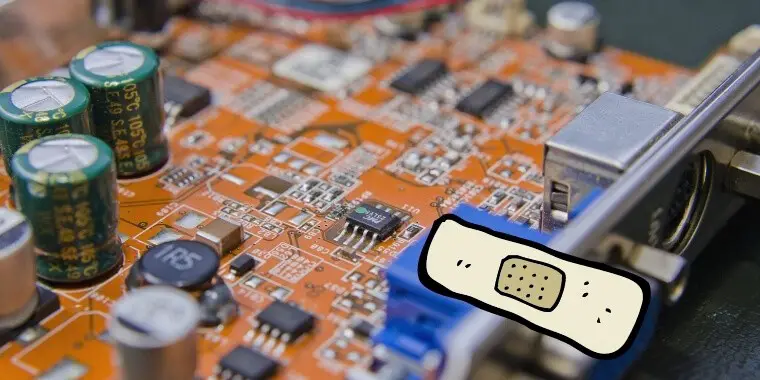Computer Monitor Keeps Turning Itself on and Off Again

Table of Contents
- Causes of Monitor Turning OFF and ON Repeatedly
- Cause 1: Monitor Overheating
- Cause 2: Loose Cables
- Cause 3: Defective or Malfunctioning Graphic Card
- Cause 4: Malfunctioning Power Supply Unit (PSU)
- Cause 5: Screen Saver or Activated Energy Saving Mode
- Conclusion
So, you have just started your day by having a healthy breakfast and turning your computer ON. A few minutes have passed while working on the computer. Suddenly, the monitor goes OFF and turns ON! Okay, this may not bother you. You keep calm and start working again. However, after some time, this ON and OFF trait repeats!
This time, you seriously start thinking that something is wrong. You start thinking about why my monitor turns OFF and ON repeatedly. Well, you are not alone. Many computer users tend to face this issue and they say that it indicates some troubleshooting to know and fix the cause.
In this post, let's go through the causes as well as the solutions of this problem.
Causes of Monitor Turning OFF and ON Repeatedly
A couple of issues can cause your monitor to turn OFF and ON. While some of them are associated with the monitor, a few relate to the computer system. Following are these causes:
Cause 1: Monitor Overheating

When a monitor is overheating, it automatically goes OFF to keep circuitry damage at bay. The reasons for overheating are excessive heat, dust accumulation, or vent blockage.
If the monitor is old, too much dust accumulation jams the monitor vents due to which the heat cannot escape. This can result in turn OFF to keep the risk of disrupting the circuitry.
Another cause in the case of an old monitor is the set of aging capacitors within the monitor circuits that are unable to retain the charge for sufficient time for supplying it to the other parts.
Solution:
If overheating is the cause, disconnect the monitor and allow it to cool completely prior to connecting it again for use. Before you put it back to use, do clean the vents using a vacuum cleaner gently. Alternatively, you can use anti-static canned air to blow away the dust inside the casing of the monitor.
If the room in which the computer is present is hot, cool it down via an AC or a fan. Allow the room to cool prior to using the monitor again. If aging capacitors are the cause, consider reducing the brightness of your monitor.
Doing so consumes less power due to which you can then use the monitor. In the case of a very old CRT model, consider replacing it with a flat-panel display to fix several heat-based issues at once.
Cause 2: Loose Cables

At times, carelessness or a silly thing can be the cause of this monitor issue. In the case of the monitor turning OFF and ON, this can be a loose display cable. So, just examine the cable that connects the monitor to the system and see whether it is loose or not.
The same problem can be with the power cable or cord that connects the monitor with the socket. If it is not well connected to the monitor's back, it results in power loss due to which the monitor tends to turn OFF.
At times, the monitor cables could be damaged via twists and pinches whose symptoms are visible at the ends. This can short-circuit the signal and make the screen go black.
Solution:
As a wise user, the first thing to do is to unplug both the monitor display cable and the monitor power cord and re-plug them securely and tightly. For this, just see both the ends of each cable at the rear of the monitor.
The power cord runs from the electrical outlet to the monitor. Once found, remove it and reconnect it. The display cable responsible for rendering the visuals from the PC to the screen runs from the rear of the monitor to the rear of the CPU. This will be a big, black one in the form of a 15-pin VGA, DVI, or HDMI cord. Ensure that you screw the ends well.
An HDMI cable cannot be screwed but you should tightly fix it. In case of small space or too thick cord such that it cannot bend well for connection, consider investing in an HDMI adapter. Now, watch the monitor to see if the issue is resolved.
If not, it is time to check DVI and HDMI setup. If you are using these cables, you need to take care of some additional considerations. Both of them are digital signals. So, if any of them is weak or has been split using a splitter, the monitor is likely to go blank due to loss of signal strength. This can happen even if the cord is too long.
At times, an HDMI cable tends to stop functioning well due to a recent hardware setting. For instance, you may have used the cable for an external device such as a splitter instead of plugging it directly into the monitor. If this is the cause, you can test just by removing that external device.
At last, try checking with another spare HDMI cable. If this does not fix the issue, consider buying a new but thicker HDMI cable to get a strong signal.
In case of a damaged cable, unplug it and physically check it for bent pins, tears, twist marks, and pinch marks. To uproot this cause, you will have to replace the cable. If there are bent pins, you can first try straightening them with a screwdriver after disconnecting the cable.
Don't miss: How To Fix Green Computer Screen?
Cause 3: Defective or Malfunctioning Graphic Card

Another common cause of the monitor turning OFF and ON frequently is faulty GPU. You can easily check if this is the cause in your case.
To do so, just remove the graphics or video card and watch the system for the monitor's issue. If resolved, it means that the GPU was at the fault. In some cases after monitor turning on you might face Generic PnP Monitor Error that's also caused by GPU.
This cause is common in case of an external GPU card, which could be dead or faulty. Here, for verification, consider using the graphics port integrated into your motherboard. These days, most CPUs or motherboards come with built-in graphics. If it worked, it means that the external GPU card is faulty or its driver is obsolete or not updated.
Solution
You first should update all the graphic card drivers. You can download and install the latest drivers from the official website of its manufacturer. To know the manufacturer and update these drivers without going to the official website, perform the following steps:
- In the search box of the Start menu or on the Taskbar, enter device manager.
- Select Device Manager. The Device Manager window is displayed.
- Locate and expand the Display adapter node.
- Look for an entry that says Intel, graphics, AMD, ATI, VGA, or NVIDIA. These are the popular brand or manufacturer names.
- Double-click the entry of your graphics or video card. The Properties dialog box is displayed.
- Select the Driver tab.
- Click Update Driver.
If the issue is still there, consider cleaning the card and put it again on the motherboard. If doing also does not resolve the issue, the only solution then is to replace the graphic card with a new one.
Cause 4: Malfunctioning Power Supply Unit (PSU)
If the connection to your PSU is loose, it can make the monitor go OFF and ON often, especially while playing games. Chances are high for your PSU to feel the burden of a giant GPU. Sometimes, dust on the PSU and its fans can cause the issue. To check that this is the case, open your CPU and see if the connection to the PSU is proper.
Solution
Clean the PSU and its fans. If the issue is still there, test with another powerful PSU, which only a technician can do safely for you. It is not recommended to do this on your own. If this new PSU solves the problem, it means the problem is with the existing PSU. So, you need to buy a new PSU.
Something you may be interested in: Why is Keyboard Not In Alphabetical Order?
Cause 5: Monitor Turns Off and On Repeatedly Because Of Screen Saver or Activated Energy Saving Mode

If you have enabled the screen saver or are using the Energy Saving mode, it can force the monitor to go OFF and ON. It can even power it OFF completely.
Solution:
To negate this cause, perform the following steps to reset the power options and stop the screen saver:
- Hold the Windows logo key and press the R key to open the Run dialog box.
- Enter powercfg.cpl. The Power Options widget is displayed.
- Ensure Balanced or High Performance is selected and corresponding to it, click Change plan settings. The Edit plan settings window is displayed.
- Set Turn off the display to Never.
- Click Apply.
- Open the Run dialog box again and enter desk.cpl,,@screensaver. The Screen Saver Settings window is displayed.
- Set the Screen saver drop-down field to None.
- Click Apply.
Now, see if the problem is resolved.
If these fixes do not work for you, it is time to repair or replace the monitor.
You may be also interested in:
- How To Fix Green Pixels Showing On My Monitor?
Conclusion
It is easy to fix the issue of the monitor turning OFF and ON repeatedly by trying one or more solutions mentioned above.
Source: https://techtreatbox.com/monitor-turns-off-and-on-repeatedly/#:~:text=Cause%201%3A%20Monitor%20Overheating,-When%20a%20monitor&text=The%20reasons%20for%20overheating%20are,risk%20of%20disrupting%20the%20circuitry.
0 Response to "Computer Monitor Keeps Turning Itself on and Off Again"
Post a Comment